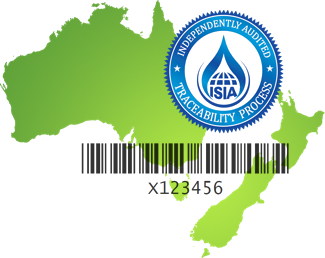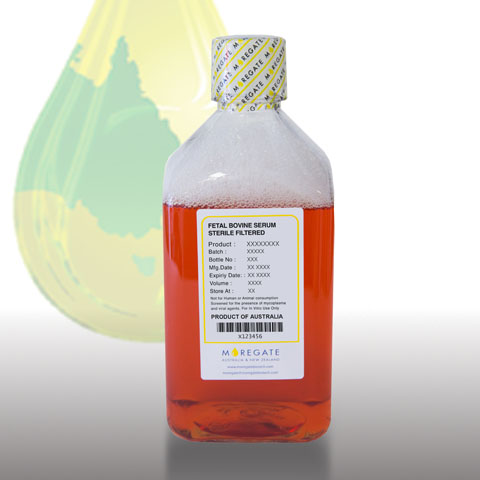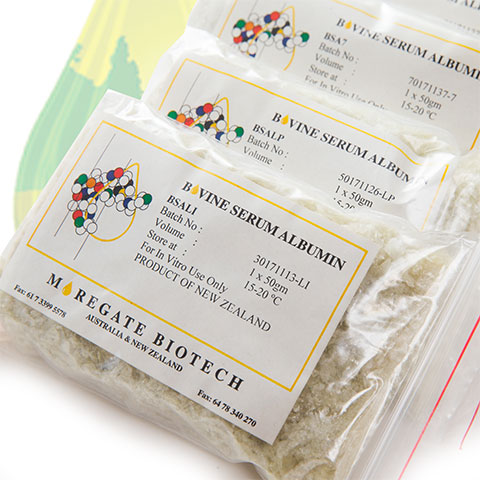Traceability
Complete Traceability of all products is assured by a comprehensive chain of documentation. The traceability of Fetal Bovine Serum and Bovine Serum Albumin is shown below as a sample of the stringent monitoring of all our products.
This image highlights three significant components of the Moregate Biotech Traceability regime.
The map: Our exclusive geographical sourcing, restricted to Australia and New Zealand only.
The barcode: State of the art tracking of all material with computer linked documentation.
The ISIA Traceability Certification logo: Evidence that we have been independently and successfully audited against the exacting and highly regarded International Serum Industry Association Traceability Audit Program. http://www.serumindustry.org/traceability.htm
Our customers demand absolute surety of traceability and Moregate Biotech provides that surety.


Traceability of Australian Origin Bovine Serum (FBS)
Bovine Serum produced in Australia & New Zealand by Moregate BioTech is processed from blood collected only at Government licensed export abattoirs.
The following information describes the tracking documentation and associated processes as well as the farming and processing procedures.
All farms are registered under a national scheme.
Cattle are tagged with a tail tag, which identifies the farm of origin. Many are also ear tagged with the individual animal's number as assigned by the farm.
When cattle are transported from the farm to another farm or to a saleyard or to an abattoir the individual details of each animal in each load of cattle are listed on a State Department of Agriculture Stock Movement Permit.
When cattle arrive at the destination their tags are checked against the Stock Movement Permit. Copies of these Stock Movement Permits are held by the State Department of Agriculture.
Once stock is at the abattoir, the details of the animals to be slaughtered are put on a “kill sheet”. Prior to slaughter each animal is subject to an ante mortem veterinary inspection.
As each animal is readied for slaughter, details of all tags are checked against the "kill sheet". Each animal on the kill sheet has a sequential number assigned by the abattoir. Immediately after slaughter this number is attached to the body as well as the head and viscera for identification purposes during post mortem veterinary inspection. All parts of the animal, including the foetus, that fail to pass the post mortem inspection are condemned and separately disposed of.

Blood is collected from foetuses of slaughtered pregnant cows that have passed post mortem veterinary inspection.
These foetuses are removed to a separate dedicated room to ensure physical isolation from any possibility of environmental contamination of contamination by condemned material. Blood is collected by aseptic cardiac puncture to further ensure against contamination.
Blood is chilled and packed in ice for overnight transport to Moregate BioTech. The number of blood bags from each abattoir is recorded on a numbered delivery docket that accompanies each shipment.
Blood arrives at Moregate where each abattoir's blood collected on the previous day, is weighed in on computer connected scales that record the source abattoir, number of bags, delivery docket number and net bag contents.
 From here on all the blood processed on a particular day is one daily pool of blood, that is processed to make a daily pool of serum. The day’s pool is filled into barcoded, numbered 4.5 litre bottles and frozen.
From here on all the blood processed on a particular day is one daily pool of blood, that is processed to make a daily pool of serum. The day’s pool is filled into barcoded, numbered 4.5 litre bottles and frozen.
All the cattle killed at each abattoir can be considered as having contributed to that day’s pool of serum. The details of each animal slaughtered are recorded and archived at the abattoir. Each bottle is numbered and has a production date recorded for it.
Prior to filtration each 4.5 litre bottle that will be used in the filtration pool is computer flagged as selected for that sterile filtered batch.
The bottles pooled for filtration come from a range of daily raw serum pools.
Using the above information, the batch of filtered serum which is derived from a homogeneous pool of raw serum, can be identified as being produced from blood collected at certain abattoirs on certain days. The details of the cattle slaughtered at these abattoirs on these days are recorded on the kill sheet.
In this way the batch of filtered serum can be traced back to the slaughtered cattle and the farms they originated from.
 Many cows selected for sale and slaughter are pregnant. These cows are treated the same way as other cows, steers, heifers and bulls.
Many cows selected for sale and slaughter are pregnant. These cows are treated the same way as other cows, steers, heifers and bulls.
Each foetus contains anywhere from 200ml to over 2 litres of blood depending on the age and size of the foetus at the time of slaughter.
When full, each bag contains approximately 800ml of blood. All bags are completely filled; therefore each bag may contain blood from between 1 to 3 foetuses.
All blood bags are centrifuged and the serum is expressed from the bags, re-centrifuged & then pooled in an intermediate vessel and filled into 4.5 litre bottles. These are weighed on computer-connected scales, a bar-coded label is printed and attached to the bottle.
Details of each batch are computer recorded and the bottles containing the raw serum are then frozen.
Bottles of raw serum for filtration are removed from the raw serum freezer, the barcode scanned for traceability and the raw serum thawed and pooled. Approximately 230 x 4.5 litre bottles of raw serum are pooled for each 1000 litre batch of filtered serum.

Traceability of Australian Origin Bovine Serum Albumin (BSA)
Bovine Serum Albumin produced in Australia by Moregate BioTech is processed from plasma collected at Government Licensed Export Abattoirs in New Zealand. The following information describes the tracking documentation and associated processes. Including the related farming and processing procedures.
New Zealand origin plasma is shipped to Australia for further processing.
 All farms are registered under a national scheme.
All farms are registered under a national scheme.
Cattle are tagged with a tail tag, which identifies the farm of origin. Many are also ear tagged with the individual animal's number as assigned by the farm.
When cattle are transported from the farm to another farm or to a saleyard or to an abattoir the individual details of each animal in each load of cattle are listed on a State Department of Agriculture Stock Movement Permit.
As each animal is readied for slaughter, details of all tags are checked against the "kill sheet". Each animal on the kill sheet has a sequential number assigned by the abattoir. Immediately after slaughter this number is attached to the body as well as the head and viscera for identification purposes during post mortem veterinary inspection. All parts of the animal, including the foetus, that fail to pass the post mortem inspection are condemned and separately disposed of.
Blood is collected from slaughtered cattle that have passed post mortem veterinary inspection. The details of each animal slaughtered on each day are recorded on the kill sheet and archived at the abattoir.
- Anticoagulant solution is added to the blood.
- The blood is then fed through a separator.
- Bovine Plasma is dispensed into either 25-litre bags (NZ) or 1000-litre pallecons (Australia).
- The 25-litre bags are labeled (with a barcode) and frozen at -20°C for shipping by freezer container from New Zealand to Australia accompanied by a Health Certificate.
- The 1000 litre pallecons are labeled and chilled to 4 - 6°C.
- The pallecons from the abattoir are individually numbered and this number is recorded on a numbered delivery docket and transfer certificate that accompany each shipment.
Plasma is heat-treated and the resultant solution filtered to remove precipitant. The clarified solution is ultra-filtered, dia-filtered and micro filtered prior to dispensing and freeze-drying.
All processing steps and materials used are recorded on a Batch Manufacturing Record.
 Many cows from a number of farms are slaughtered each day at each abattoir, therefore the batch of bovine serum albumin, which is derived from a homogeneous pool of raw plasma, can be identified as being produced from blood collected at certain abattoirs on certain days. The details of the cattle slaughtered at these abattoirs on these days are recorded on the kill sheet.
Many cows from a number of farms are slaughtered each day at each abattoir, therefore the batch of bovine serum albumin, which is derived from a homogeneous pool of raw plasma, can be identified as being produced from blood collected at certain abattoirs on certain days. The details of the cattle slaughtered at these abattoirs on these days are recorded on the kill sheet.
In this way the batch of bovine serum albumin can be traced back to the slaughtered cattle and the farms they originated from.




